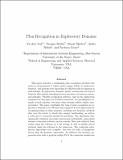| dc.contributor.author | Gal, Ya'akov | |
| dc.contributor.author | Reddy, Swapna | |
| dc.contributor.author | Shieber, Stuart M. | |
| dc.contributor.author | Rubin, Andee | |
| dc.contributor.author | Grosz, Barbara J. | |
| dc.date.accessioned | 2011-11-09T14:52:39Z | |
| dc.date.issued | 2012 | |
| dc.identifier.citation | Gal, Ya’akov, Swapna Reddy, Stuart M. Shieber, Andee Rubin, and Barbara J. Grosz. 2012. Plan recognition in exploratory domains. Artificial Intelligence 176(1): 2270-2290. | en_US |
| dc.identifier.issn | 0004-3702 | en_US |
| dc.identifier.uri | http://nrs.harvard.edu/urn-3:HUL.InstRepos:5343166 | |
| dc.description.abstract | This paper describes a challenging plan recognition problem that arises in environments in which agents engage widely in exploratory behavior, and presents new algorithms for effective plan recognition in such settings. In exploratory domains, agentsʼ actions map onto logs of behavior that include switching between activities, extraneous actions, and mistakes. Flexible pedagogical software, such as the application considered in this paper for statistics education, is a paradigmatic example of such domains, but many other settings exhibit similar characteristics. The paper establishes the task of plan recognition in exploratory domains to be NP-hard and compares several approaches for recognizing plans in these domains, including new heuristic methods that vary the extent to which they employ backtracking, as well as a reduction to constraint-satisfaction problems. The algorithms were empirically evaluated on peopleʼs interaction with flexible, open-ended statistics education software used in schools. Data was collected from adults using the software in a lab setting as well as middle school students using the software in the classroom. The constraint satisfaction approaches were complete, but were an order of magnitude slower than the heuristic approaches. In addition, the heuristic approaches were able to perform within 4% of the constraint satisfaction approaches on student data from the classroom, which reflects the intended user population of the software. These results demonstrate that the heuristic approaches offer a good balance between performance and computation time when recognizing peopleʼs activities in the pedagogical domain of interest. | en_US |
| dc.description.sponsorship | Engineering and Applied Sciences | en_US |
| dc.language.iso | en_US | en_US |
| dc.publisher | Elsevier | en_US |
| dc.relation.isversionof | doi:10.1016/j.artint.2011.09.002 | en_US |
| dash.license | OAP | |
| dc.title | Plan Recognition in Exploratory Domains | en_US |
| dc.type | Journal Article | en_US |
| dc.description.version | Accepted Manuscript | en_US |
| dc.relation.journal | Artificial Intelligence | en_US |
| dash.depositing.author | Shieber, Stuart M. | |
| dc.date.available | 2011-11-09T14:52:39Z | |
| dc.identifier.doi | 10.1016/j.artint.2011.09.002 | * |
| dash.identifier.orcid | 0000-0002-7733-8195 | * |
| dash.contributor.affiliated | Grosz, Barbara | |
| dash.contributor.affiliated | Gal, Ya'akov | |
| dash.contributor.affiliated | Shieber, Stuart | |


